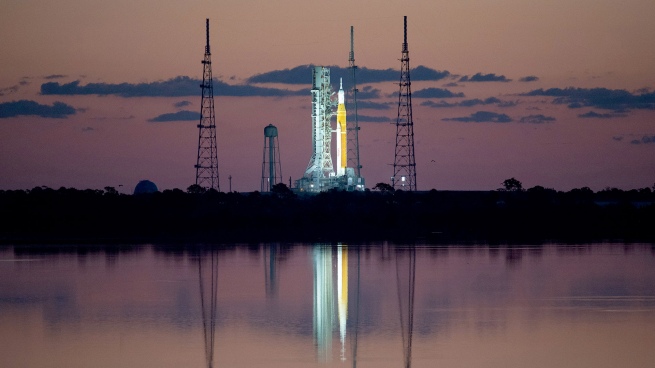Yo
This Monday the Artemis I mission will travel to the Moon, the first uncrewed flight test paving the way for establishing a long-term human presence on the satellite, and more than 100,000 people are expected to attend the launch on the NASA Kennedy Space Center, Florida, United Statesto feel the noise of the explosion and the “vibration in the chest” of the most powerful rocket in history, Pablo de León, an Argentine scientist at that US body, described Télam.
If the Apollo program made Neil Armstrong the first human being to set foot on the Moon in 1969, now NASA seeks to bring by 2025 “the first woman and first person of color”, As reported.
“The mission that will take off on Monday is part of a NASA’s largest program and marks the return to the Moon after more than 50 years,” explains to Télam De León from North Dakota, where he directs the Manned Space Flight Laboratory.
The aerospace engineer, a native of Cañuelas, anticipates that “the missions of the Artemis program will lead to prolonged stays on the Moon that will end with the establishment of permanent bases.”
It took 50 years since the last time a man walked on our satellite, in 1972, for NASA to create the continuation of the Apollo program and baptize it Artemis in honor of Artemis, the twin sister of Apollo and goddess of the Moon, hunting and nature in Greek mythology.
“This program will allow testing the technologies that will serve for the manned exploration of Mars, which is the other great objective”, ccontinues De León, who has been a researcher at NASA for more than 30 years.
And he details: “The Moon, as it is only three days from Earth, and not almost a year like Mars, will allow us to test all these technologies, many of them critical, close to home.”

For its part, Raúl Kulichevsky, executive and technical director of the National Commission for Space Activities (Conae), he comments to Télam that “now it is time to return to the Moon but as an intermediate step towards exploring the possibility that man can live on other planets”.
“Beyond all the technological challenges, there is still a lot to study how the human body will react to living permanently in weightless conditions,” adds the aeronautical engineer.
The objective is not only to use the Moon as a springboard to other planets, but also that our natural satellite has resources for the production of oxygen and water that could be used.
“Space mining is something that has been thought about for a long time and the Moon is the closest element we have,” says De León.
How will the mission
NASA’s most ambitious plan to explore the Moon will begin this August 29, weather permitting, with the Artemis I mission which is already on the Cape Canaveral launch pad, on the East Coast of the United States, and It will have a total duration of 42 days, 3 hours and 20 minutes.
The takeoff It will have a two-hour window from 8:33 a.m. EDT to 10:33 a.m. EDT, so the launch must necessarily occur within that time or the flight will be postponed until September 2 or 5.
“That’s because you have to launch at a certain time. You don’t launch to where the Moon is, you launch to where the Moon is going to be when the ship arrives there, so there is a whole theme of celestial mechanics, which is a kind of dance between celestial bodies,” explains De León.

According to the latest weather reports, a 70% chance of favorable weather conditions is anticipated for launch this Monday, while the main concern is scattered rain.
Artemis I is the first integrated test of NASA’s deep space exploration systems: the Orion spacecraft, the Space Launch System (SLS) rocket, and the ground systems at the Kennedy Space Center in Florida that will maintain communication as the spacecraft moves toward the Moon.
Orion it will fly farther than any spacecraft built for humans has ever flown, surpassing the Apollo 13 distance record.
The spacecraft will travel 450,000 kilometers from Earth, will reach 64,000 kilometers beyond the far side of the Moon and will return to Earth to plunge into the Pacific Ocean off the coast of California, according to NASA.
What the flight is unmannedwill ride in the commander’s seat mannequin “Moonikin Campos”named in memory of Arturo Campos, the engineer who played a key role in the safe return of Apollo 13 to Earth.
Moonikin will wear the full astronaut suit and will be accompanied by two torsos named Helga and Zohar, who will occupy the two lower seats of the ship and measure the space radiation that astronauts may experience.
At the bottom of Orion will be the service module produced by the European Space Agency (ESA), a cylinder 4 meters high and in diameter and weighing 13 tons that It will provide electricity to the spacecraft and propel it toward its lunar orbit.

for takeoff, the Space Launch System will be used (SLS), NASA’s most powerful rocket with a height of 98 meters and which marks “a before and after in all that is international space activity”, Kulichevsky considers.
The launch is expected to be “truly impressive,” says De León, and he is excited to imagine what he will experience on Monday.
“The closest place you can be to the rocket is three miles, which would be more or less 5 kilometers. by the shock wave and the sound”, he specifies and warns that “even so, at the moment of takeoff, you feel the vibration in the chest that enters into resonance with the rocket, it is an indescribable sensation”.
According to the Florida Space Coast Tourism Office, more than 100,000 visitors are expected to witness the launch on Monday morning.
many expectations
On how the previous hours are lived in the corridors of NASA, De León comments that “there are a lot of expectations, but there is also concern because NASA has not done this type of deep space mission for a long time and that a rocket has not been launched so big”.
Only in 2024 is the first manned mission with four astronauts expected, Artemis II, which will also sail around the Moon.
And Artemis III is expected to be the mission that will return humans to the Moon in 2025, when four more astronauts land on the uncharted surface of the lunar south pole.
But everything will depend on how the test launch turns out this Monday, when three mannequins and some 100,000 people on the shore of the space center feel the vibrations of the most powerful liftoff in history in their chests.


















